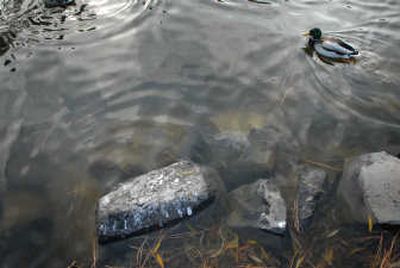Feeding fouls Manito duck pond

The cause of the smelly green water of the Manito duck pond is in plain sight.
On the September day that wildlife biologist Mike Rule examined the water in the south Spokane park, a visitor came with a grocery cart full of day-old bread and emptied it into the pond – or more accurately, emptied it into ducks and seagulls.
“It’s such a concentrated amount of fecal matter in there,” said Rule, who works for the Turnbull National Wildlife Refuge south of Cheney. “I don’t know how you’re going to solve it as long as you’ve got people who want to continue feeding.”
The feeding of birds at the pond has created a large resident population of ducks, mostly mallards, with a smattering of farm ducks and some of mixed heritage. Their poop feeds summertime algae blooms that deplete oxygen in the water.
Less oxygen means fewer fish, frogs and other aquatic life that otherwise might thrive in the pond. This summer, visitors complained that the pond’s green hue was more fluorescent and its odor more rank than usual.
Those concerns have led park leaders to ponder ways to clean the water.
“The volume of food that’s going in there is just incredible,” said Steve Nittolo, Spokane parks horticulture supervisor. “We’re just trying to improve it as an ecologically sound pond.”
In a recent count, there were 260 ducks and 30 geese in the pond.
Nittolo said the plan he will propose to the parks board next year would not ban duck feeding but instead try to reduce it through public education.
“We’re not asking to prohibit anyone from anything,” Nittolo said.
The plan, which also will examine water quality at Cannon Hill Park pond and in the Spokane River in front of the Riverfront Park carousel, also might include measures such as filtration systems or landscaping to prevent erosion.
Lynn Caruso, who lives near Manito Park, was at the pond Tuesday supervising her son and his two friends as they fed the ducks. Caruso said they would continue to enjoy visits to the pond even if they were discouraged from feeding, but they would miss the interaction with the birds.
“At least for us, it’s a definite draw to the park as much as going to the play structure,” she said.
Rule, the wildlife biologist, said he recommended a few options to Nittolo after examining the pond. One was to end feeding. Another was to let the pond dry up in the fall, but park officials have rejected that option. The water quality doesn’t bother mallards much, as long as they get easy food, Rule said.
“There’s probably not much natural food left in that system,” he said.
The regular feedings and the ducks’ adaptability to human presence make Manito a popular hangout.
The population of Canada geese there likely is more natural, Rule said. While they sometimes participate in the dog food and bread feeding frenzies, they mostly eat grass along the shore.
If the feeding ended, some geese would move on to other ponds or lakes. Some might fly south for the winter, but others would remain year-round, Rule said.
The bird poop creates other problems. “It is a mess and I would say it’s a health hazard, too,” Nittolo said.
Rule said parents should make sure their children wash their hands if they touch the feces-infested ground. He added that having such a large population of ducks could be problematic if there’s an outbreak of disease.
The park staff can’t keep up with the duck droppings, so it’s not removed, Nittolo said.
“It just wears off,” he said. “As soon as you clean it up, it’s going to be messed up again.”